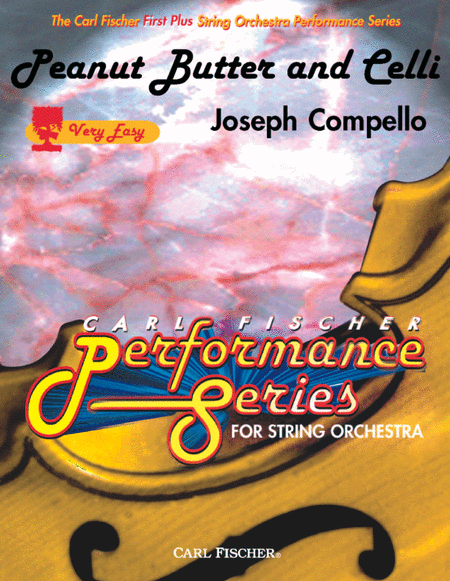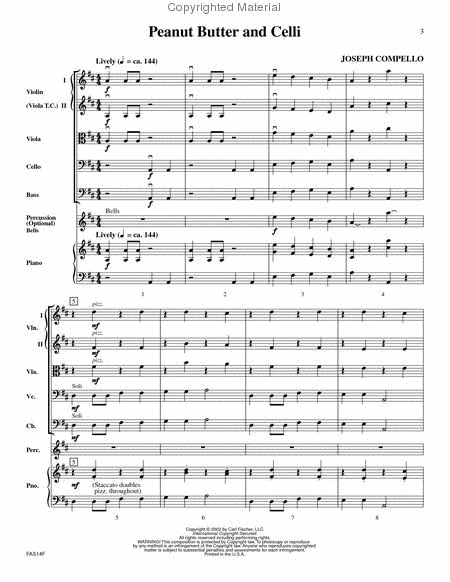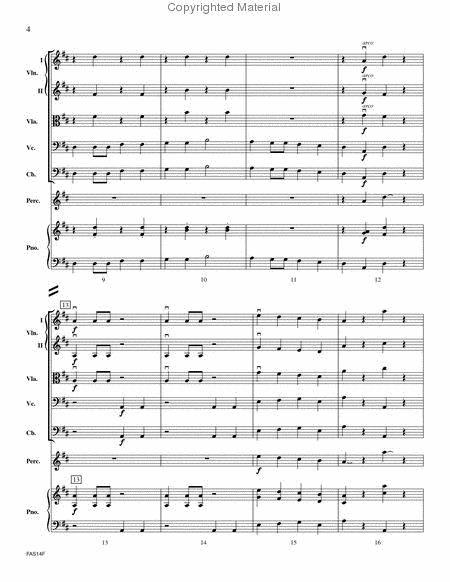Peanut Butter And Celli
Full Score and Parts
-
Ships in 1 to 2 weeks
Details
Description
SKU: CF.FAS14
Full Score and Parts. Composed by Joseph Compello. Edited by Amy Rosen. Carl Fischer First Plus String Orchestra Series. Score and Parts. With Standard notation. 8+8+5+5+5+1+2+12 pages. Carl Fischer Music #FAS14. Published by Carl Fischer Music (CF.FAS14).ISBN 9780825847851. UPC: 798408047856. 8.5 X 11 inches. Key: D major. Text: Joseph Compello. Joseph Compello.
Peanut Butter and Celli may be performed as a section solo for low strings or as a solo for either cello or bass. Rhythmically, the music is no more complicated than two eighth notes in any one measure. Only one pitch is used for any pair of eighth notes. Strive for a brisk tempo. Articulation should be light and bouncy except for the legato line in violin I at mm. 25 through 31. The slurs are optional in this section. If the optional repeat is not taken at m. 48, the director must select arco or pizzicato at m.42. At m. 52 the lower octave is given as an option if the director wishes to avoid the low 2 fingering in the upper octave. If bells are used, violin I may take the upper or lower octave in that measure. The little cadenza, which first appears at m 37, should start around 120 beats per minute and gradually become slower and slower. Prior to the cadenza, the ensemble will ask, How low can you go? Be certain that the words are spoken together, distinctly and slowly. Give a slight upward inflection to the words low and go. The bells part is completely optional. Measure 51 may be played as a bells solo. Peanut Butter and Celli will provide an excellent opportunity to feature the low strings at recruitment concerts. Playing time with the repeat is about two and one-half minutes. Thank you for choosing this composition. I hope you and your students find it enjoyable and instructive. Your comments are most welcome. -Joseph Compello Glen Arm, Maryland, 2002.
Peanut Butter and Celli may be performed as a section solo for low strings or as a solo for either cello or bass. Rhythmically, the music is no more complicated than two eighth notes in any one measure. Only one pitch is used for any pair of eighth notes. Strive for a brisk tempo. Articulation should be light and bouncy except for the legato line in violin I at mm. 25 through 31. The slurs are optional in this section. If the optional repeat is not taken at m. 48, the director must select arco or pizzicato at m.42. At m. 52 the lower octave is given as an option if the director wishes to avoid the low 2 fingering in the upper octave. If bells are used, violin I may take the upper or lower octave in that measure. The little cadenza, which first appears at m 37, should start around 120 beats per minute and gradually become slower and slower. Prior to the cadenza, the ensemble will ask, How low can you go? Be certain that the words are spoken together, distinctly and slowly. Give a slight upward inflection to the words low and go. The bells part is completely optional. Measure 51 may be played as a bells solo.A Peanut Butter and Celli will provide an excellent opportunity to feature the low strings at recruitment concerts. Playing time with the repeat is about two and one-half minutes. Thank you for choosing this composition. I hope you and your students find it enjoyable and instructive. Your comments are most welcome. -Joseph Compello Glen Arm, Maryland, 2002.
Peanut Butter and Celli may be performed as a section solo for low strings or as a solo for either cello or bass. Rhythmically, the music is no more complicated than two eighth notes in any one measure. Only one pitch is used for any pair of eighth notes. Strive for a brisk tempo. Articulation should be light and bouncy except for the legato line in violin I at mm. 25 through 31. The slurs are optional in this section. If the optional repeat is not taken at m. 48, the director must select arco or pizzicato at m.42. At m. 52 the lower octave is given as an option if the director wishes to avoid the low 2 fingering in the upper octave. If bells are used, violin I may take the upper or lower octave in that measure. The little cadenza, which first appears at m 37, should start around 120 beats per minute and gradually become slower and slower. Prior to the cadenza, the ensemble will ask, "How low can you go?" Be certain that the words are spoken together, distinctly and slowly. Give a slight upward inflection to the words "low" and "go." The bells part is completely optional. Measure 51 may be played as a bells solo.A Peanut Butter and Celli will provide an excellent opportunity to feature the low strings at recruitment concerts. Playing time with the repeat is about two and one-half minutes. Thank you for choosing this composition. I hope you and your students find it enjoyable and instructive. Your comments are most welcome. -Joseph Compello Glen Arm, Maryland, 2002.
Peanut Butter and Celli may be performed as a section solo for low strings or as a solo for either cello or bass. Rhythmically, the music is no more complicated than two eighth notes in any one measure. Only one pitch is used for any pair of eighth notes. Strive for a brisk tempo. Articulation should be light and bouncy except for the legato line in violin I at mm. 25 through 31. The slurs are optional in this section. If the optional repeat is not taken at m. 48, the director must select arco or pizzicato at m.42. At m. 52 the lower octave is given as an option if the director wishes to avoid the low 2 fingering in the upper octave. If bells are used, violin I may take the upper or lower octave in that measure. The little cadenza, which first appears at m 37, should start around 120 beats per minute and gradually become slower and slower. Prior to the cadenza, the ensemble will ask, "How low can you go?" Be certain that the words are spoken together, distinctly and slowly. Give a slight upward inflection to the words "low" and "go." The bells part is completely optional. Measure 51 may be played as a bells solo. Peanut Butter and Celli will provide an excellent opportunity to feature the low strings at recruitment concerts. Playing time with the repeat is about two and one-half minutes. Thank you for choosing this composition. I hope you and your students find it enjoyable and instructive. Your comments are most welcome. -Joseph Compello Glen Arm, Maryland, 2002.
Peanut Butter and Celli may be performed as a section solo for low strings or as a solo for either cello or bass. Rhythmically, the music is no more complicated than two eighth notes in any one measure. Only one pitch is used for any pair of eighth notes. Strive for a brisk tempo. Articulation should be light and bouncy except for the legato line in violin I at mm. 25 through 31. The slurs are optional in this section. If the optional repeat is not taken at m. 48, the director must select arco or pizzicato at m.42. At m. 52 the lower octave is given as an option if the director wishes to avoid the low 2 fingering in the upper octave. If bells are used, violin I may take the upper or lower octave in that measure. The little cadenza, which first appears at m 37, should start around 120 beats per minute and gradually become slower and slower. Prior to the cadenza, the ensemble will ask, "How low can you go?" Be certain that the words are spoken together, distinctly and slowly. Give a slight upward inflection to the words "low" and "go." The bells part is completely optional. Measure 51 may be played as a bells solo. Peanut Butter and Celli will provide an excellent opportunity to feature the low strings at recruitment concerts. Playing time with the repeat is about two and one-half minutes. Thank you for choosing this composition. I hope you and your students find it enjoyable and instructive. Your comments are most welcome. -Joseph Compello Glen Arm, Maryland, 2002.
Peanut Butter and Celli may be performed as a section solo for low strings or as a solo for either cello or bass.Rhythmically, the music is no more complicated than two eighth notes in any one measure. Only one pitch is used for any pair of eighth notes.Strive for a brisk tempo. Articulation should be light and bouncy except for the legato line in violin I at mm. 25 through 31. The slurs are optional in this section.If the optional repeat is not taken at m. 48, the director must select arco or pizzicato at m.42.At m. 52 the lower octave is given as an option if the director wishes to avoid the low 2 fingering in the upper octave. If bells are used, violin I may take the upper or lower octave in that measure.The little cadenza, which first appears at m 37, should start around 120 beats per minute and gradually become slower and slower. Prior to the cadenza, the ensemble will ask, "How low can you go?" Be certain that the words are spoken together, distinctly and slowly. Give a slight upward inflection to the words "low" and "go."The bells part is completely optional. Measure 51 may be played as a bells solo. Peanut Butter and Celli will provide an excellent opportunity to feature the low strings at recruitment concerts.Playing time with the repeat is about two and one-half minutes.Thank you for choosing this composition. I hope you and your students find it enjoyable and instructive. Your comments are most welcome.-Joseph CompelloGlen Arm, Maryland, 2002.



 Share
Share